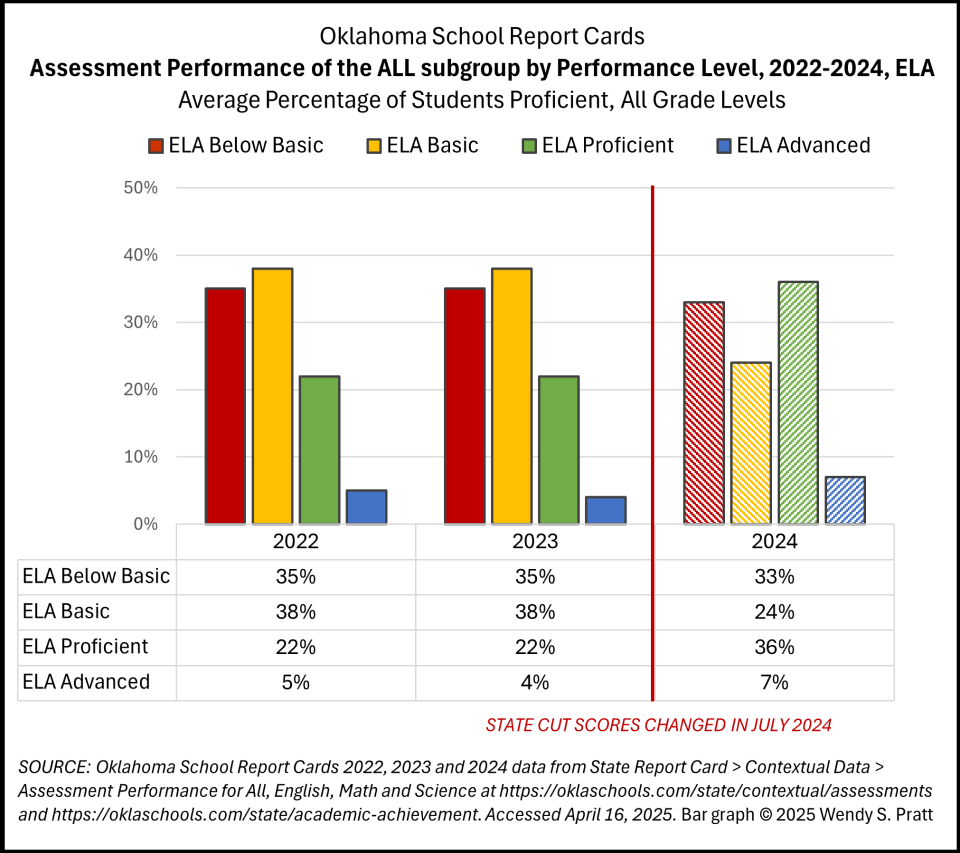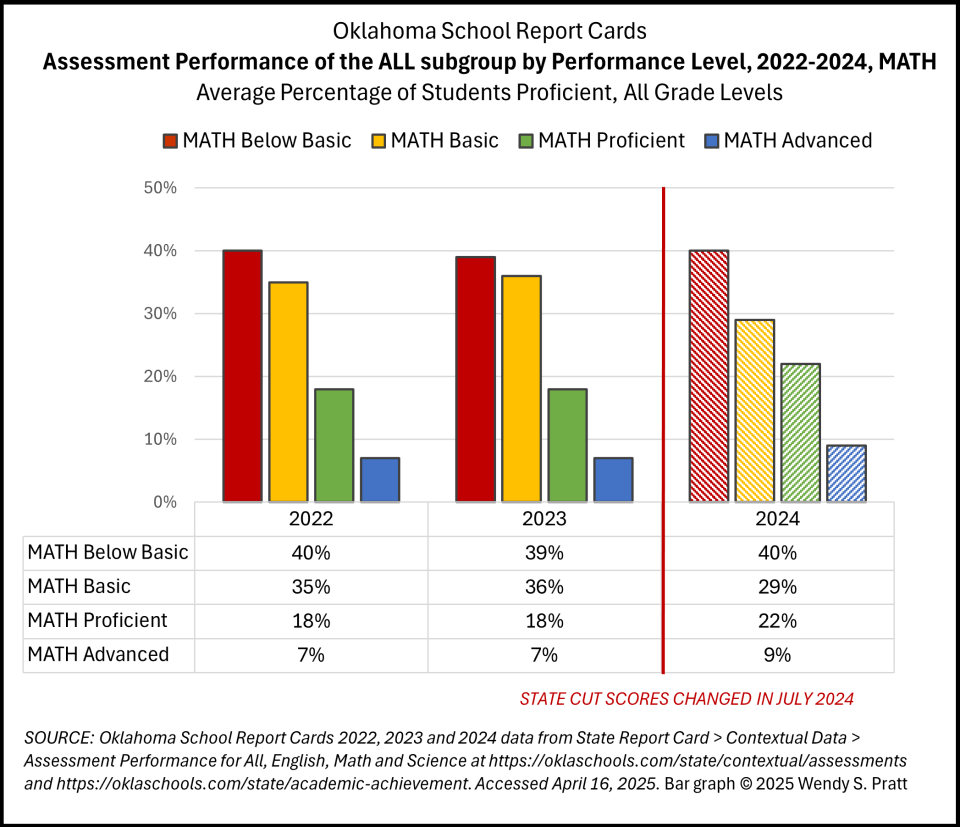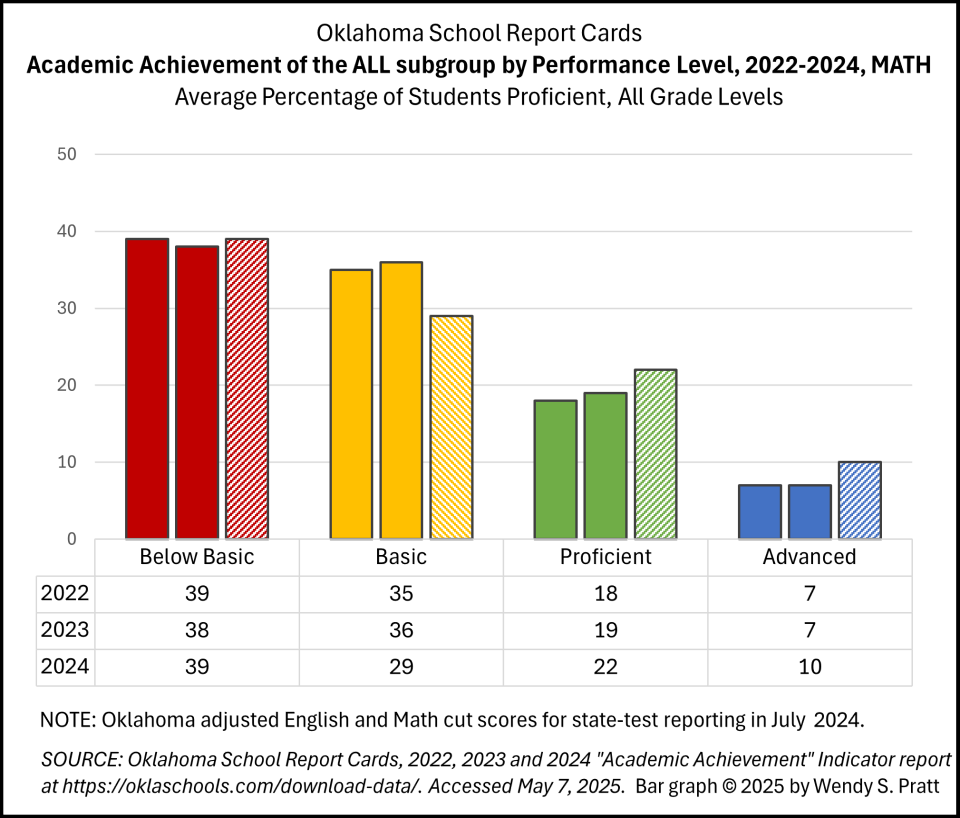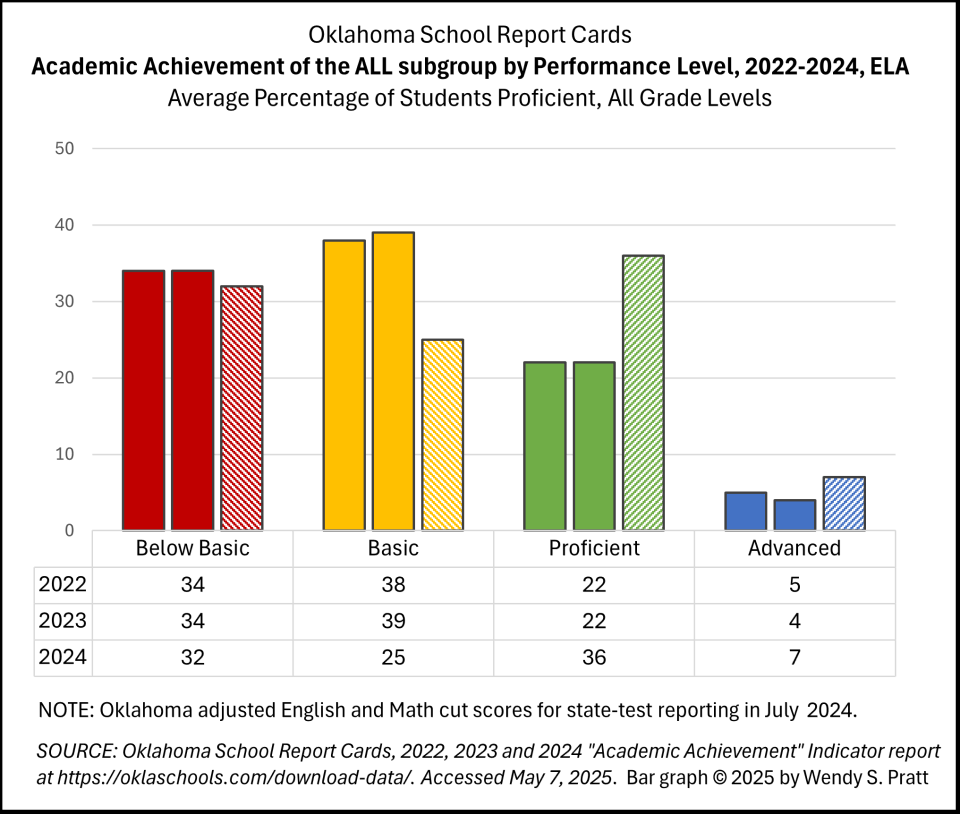PROJECT 1: Oklahoma School Performance 2024
What does lowering cut scores on state tests in 2024 mean for Oklahoma in 2025?
by Wendy Pratt
Posted on LinkedIn May 12, 2025
Mind-boggling is one description for all that is going on with K-12 education in Oklahoma these days. Rarely a dull moment! But, at every pause, my mind goes back to 2024 scores on state tests of the Oklahoma Academic Standards (OAS).
Why? Because teaching and learning the OAS are the primary requirements of public schools in state law. Yet, today, the standards are a bigger political football than ever and comparing academic performance among schools or across years is shrouded in confusion. The lack of urgency about last year’s test results may be because leaders miss the direct connection from the standards to state-test results to national rankings.
For years, I had a bad habit of celebrating even small improvements in student proficiency on state tests because it usually requires a LOT of hard work by a dedicated team. It CAN also mean that a school community takes seriously their requisite Continuous Improvement Plan. Unfortunately, the data that triggers Oklahoma’s school-improvement process may no longer be valid or reliable.
This is the same data used by the state to identify the lowest-performing five percent of schools in compliance with federal law. [See related article here.]
This is the same data that will be used by the Oklahoma State Department of Education (OSDE) this summer to determine school accreditation deficiencies under their new rules.
In various roles, I have analyzed the Oklahoma School Testing Program (OSTP) data every year since the state switched to standards-based assessments in 1994-95. States set their own standards and administer tests as mandated in federal law, which means the scores are not comparable. National rankings mainly come from a whole different set of data, the National Assessment of Educational Progress (NAEP). [Related article here.]
Since July 2024, when the state lowered OSTP cut scores (also called “cut points” or “benchmarks”) for English and mathematics, some of us have been trying to figure out what the change means to state accountability and how it impacts alignment with the rigor of the NAEP. While the OSDE’s process was similar to previous standard settings, the results were surprising. Full disclosure: I did not read every page of the 242-page report on the process but Oklahoma Voice covers it well. They note that past standard settings made scoring at the proficient level harder, not
easier. From their March 18 report:
The last time Oklahoma test results changed so dramatically was in 2017 when the state updated its scoring methods to align with national standards. The 2017 revision caused proficiency levels to drop by as much as 43% in a single year. Back then, schools and the public were informed before test results were released that there would be significant differences. The state Education Department held media briefings before distributing the results to warn Oklahomans of the impending performance drop.
Apparently, no warning is needed when the scores improve; but also the increase in 2024 is not nearly as great as the decrease in 2017.
There are at least two ways to evaluate the change in cut scores using data from the Oklahoma School Report Cards site (https://oklaschools.com). One is with the “Assessment Performance” data, reported by performance level for all students in composite for all grade levels (Grades 3-8 and 11) under “Contextual Data.”
On the state tests of English Language Arts (ELA) from 2022 to 2023, the proficiency rate (sum of Proficient and Advanced scores) increased 1 percentage point; last year, ELA proficiency rate increased 17 percentage points. In Math, no change was reported in the state average from 2022 to 2023, but proficiency increased 6 percentage points last year. [Graphs at top of this page.]
Another way to look at the change is using the “Academic Achievement” data under “Indicators” from the same platform. The graphs (right) also use the ALL subgroup and the composite for ALL grades by year for each performance level.
In both datasets, the notable increase in percent of students scoring “proficient” on the English test is suspect though I have checked it against multiple reports in the platform. …
Table to the right is one. >>>
Bottom line: Oklahomans need confidence in the data used to compare public schools IF we expect that data to mean anything to parents or educators and be actionable at the local level for school improvement. The OSDE has not adequately explained the change or what it should mean to schools and their patrons or to policymakers and other stakeholders. Hopefully, they will put it here so I can find it.
Good news: There is hope that Oklahoma’s Office of Educational Quality and Accountability will shed some independent light when their “Standard Setting Evaluation” is completed later this month. Inquiring minds would love to know what the results were before the cut scores changed.
Wherefore art thou local control?
Excerpts from Oklahoma Supreme Court Network for Oklahoma Statutes “Title 70. Schools”
§70-11-103.6. State Board of Education - Adoption of subject matter standards.
2. School districts shall develop and implement curriculum, courses and instruction in order to ensure that students meet the skills and competencies as set forth in this section and in the subject matter standards adopted by the State Board of Education.
§70-1210.508B. Legislative findings - Purpose - Reading and math instruction time.
C. Each public school district in this state shall ensure that all students receive a well-rounded education that is focused on building deep foundations in reading and mathematics. … All teachers of reading in the public schools in this state in kindergarten through third grade shall incorporate into instruction the five elements of reading instruction which are phonemic awareness, phonics, reading fluency, vocabulary, and comprehension.
§70-11-103.6b. Social studies curriculum and textbooks to reflect American diversity.
A. The State Board of Education shall adopt a social studies core curriculum with courses of instruction for all students enrolled in the public schools that reflect the racial, ethnic, religious, and cultural diversity of the United States of America. The United States history and Oklahoma history components required in the social studies curriculum for all students shall include, but not be limited to, African Americans, Native Americans, and Hispanic Americans. The United States history component required in the social studies curriculum for all students shall include information about Juneteenth commemorating emancipation of enslaved African Americans.
D. As used in this section, "curriculum" means the subject matter standards adopted by the State Board of Education pursuant to Section 11-103.6 of this title. School districts shall exclusively determine instruction, specific course curricula, reading lists and instructional materials pursuant to subsection F of Section 11-103.6a of this title.








